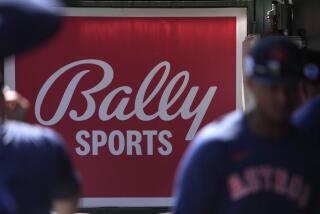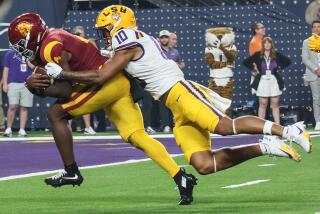COMMENTARY : Note to Congress: Leave Cable TV Alone
- Share via
When people sat down Thursday to carve their turkey, few bowed heads and gave thanks for the three TV networks. Howard Metzenbaum thinks that’s too bad. The senator from Ohio thinks of these as a national resource.
Doogie Howser, Alf and Roseanne?
No. Thank God. Howie is speaking of sports.
The Democrat is chairman of the subcommittee on antitrust and monopoly, which spent much of last week investigating the impact upon the American fan of cable’s gobbling up sports events. In a guest editorial in Monday’s editions of “USA Today,” Metzenbaum suggests that too much is on cable now, and not enough on free television, and if that trend keeps up, Congress will have to step in and do something about it.
Terrific, huh?
Drugs are destroying America’s fiber, people are dying in El Salvador’s war, AIDS is threatening to wipe out humanity, the nation’s highways fall apart when you shake them, and these clowns are sitting around taking testimony on which networks should carry what games.
“The signs,” Metzenbaum wrote, “are ominous:
“Next year, the number of nationally televised Saturday baseball games on free TV will drop from 40 to 16.
“Sunday night NFL games are on ESPN, not free TV.
“Tennessee college football fans had to pay $20 to see the Tennessee-Duke football game on television . . .”
And then he finally got to the nub of it:
“In my own state, Ohio, high school football fans in communities without cable are worried because, for the first time, the sports cable channel has an exclusive contract for the (state) championship.”
He calls cable “an unregulated monopoly.” The “new kid in the neighborhood,” he contends, is now the “bully on the block.”
My guess is that Howie doesn’t know a hoola hoop from a hockey puck.
The public has access to more “free” games than ever before -- and the numbers are swelling, not shrinking.
Tuesday, CBS announced a billion-dollar arrangement to telecast all 63 games of college basketball’s championship tournament from 1991 through ’97.
Cable network ESPN will air none. No more Dick Vitale. Too bad. R.I.P., baby.
Two weeks ago, NBC put up $600 million to do as many as 50 NBA games in each of the next four seasons -- as many as the cable networks are doing.
A few weeks before that, CBS bid more than a billion to do baseball next season -- 16 regular-season Saturday games, plus as many as 22 others.
All that, for free . . . more or less.
Of course, the word “free” is Howard’s, not mine.
Metzenbaum argues that professional sports teams get special treatment under federal law and thus have a debt to the public. He says fans who buy tickets, and those who pay taxes on sports facilities, deserve free access to the games on TV.
“The sports leagues,” he wrote, “should take steps to ensure that access to sports on TV does not depend upon an individual’s ability to pay. If they won’t, Congress may do it for them.”
Over my dead body, Howard.
What about people who can’t afford a TV?
Do we kill the B-2 and spend the dough on TVs for the homeless?
And what’s free TV, anyhow?
“Free TV” programs are financed by sponsors. All those millions and billions are paid off by firms that make cars, beer and panty hose. To make the extra dough to pay for those ads, they hike the price of their products.
You either pay the cable company or you pay the supermarket.
What’s the difference?
As for those “ominous” signs, Metzenbaum’s “ghost” seems confused.
There were 30 regular-season broadcasts last season, not 40. There aren’t 40 Saturdays in the baseball season. There are also the local TV packages augmenting the networks and pay-per-view. More than 100 San Francisco Giants games were available last season in its part of the world.
Beyond that, ESPN will cablecast 176 games next season, which is up from last season’s total of NONE.
As for football, ESPN is carrying only one pro game Sunday evenings. Except for those cities whose teams are in action, it’s in addition to what America already had.
Tennessee-Duke, for $20 on pay-per-view cable, beats the hell out of not being able to see it at all. The same is true of Ohio’s prep title game, which probably will raise all kinds of dough for the schools.
If Howard sees some kind of threat to our liberty here, it eludes me.
It also troubles Metzenbaum that cable rates have been escalating. So what about tickets? What hasn’t been escalating?
For about what it costs to get into one NBA game, you can get a month of ESPN, CNN, TNN, MTV, TBS, TDC, A&E;, PDQ, AAA and BVD. Cable reaches something like 56 percent of American households now. Add in the people with satellite dishes, those within walking distance of restaurants and taverns with cable or dishes, and those people who haven’t bought cable simply because they like books, and it’s clear three in four nationwide can watch whatever they want.
Metzenbaum makes no sense. If a thing isn’t broke, why fix it? For sports fans, times have never been better when it comes to TV.
The piece would have been funny if Metzenbaum weren’t so important a man, with the power to make life miserable for millions of sports fans. And all because some constituents have to pay to watch a prep football game. Or maybe because Metzenbaum had to.
It’s easy to see why these guys need a raise.
More to Read
Go beyond the scoreboard
Get the latest on L.A.'s teams in the daily Sports Report newsletter.
You may occasionally receive promotional content from the Los Angeles Times.










